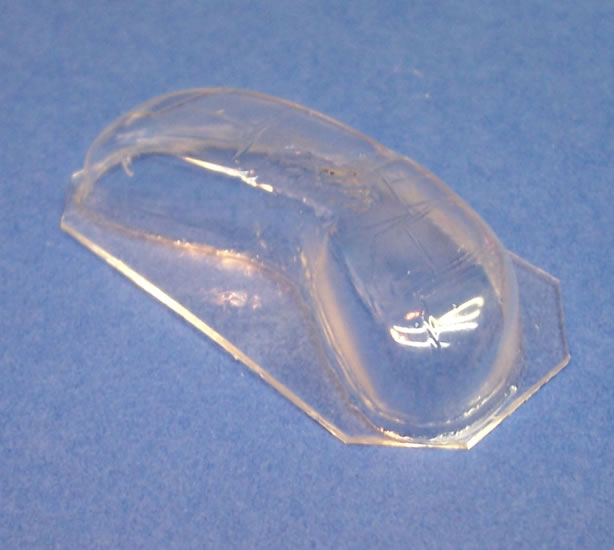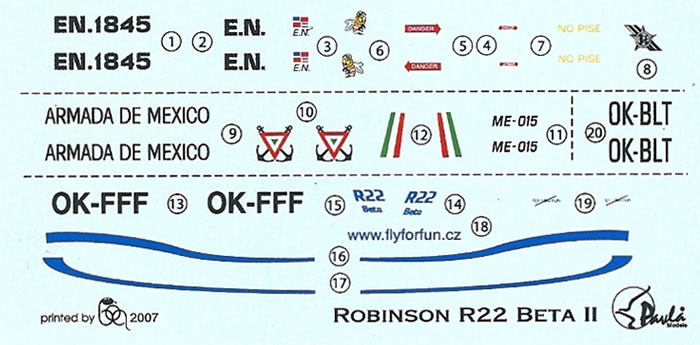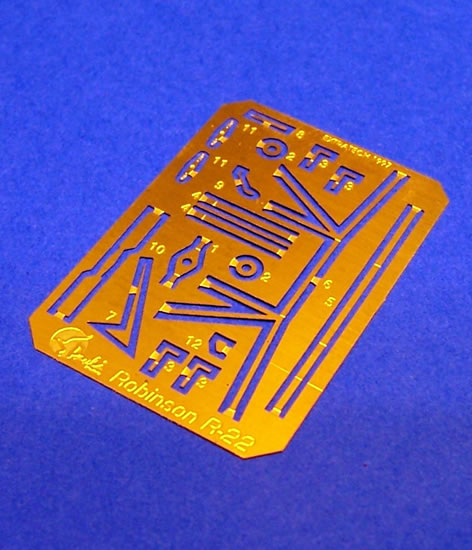Robinson R-22

Pavla, 1/72 scale
S u m m a r y : |
Catalogue Numbers: |
Pavla Kit No. 72071 - Robinson R-22 |
Scale: |
1/72 |
Contents & Media: |
- 20 x Resin airframe parts,
- 2 x Vac-form fuselage pods (plus spare pair)
- 1 x PE fret of 12 parts
- 3 x Decal subjects.
|
Price: |
Available on-line from these stockists:
|
Review Type: |
First Look |
Advantages: |
Good quality, scale finesse and some interesting colour schemes. |
Disadvantages: |
PE undercarriage struts are potentially weak and do not replicate the real aircraft’s tubular struts. |
Conclusion: |
High quality production, well packaged with good instructions and nice looking decals. The PE struts would be best replaced with a stronger tubular material. Overall a very well executed kit – Definitely recommended. |
Reviewed by
Mark Davies

HyperScale is proudly sponsored by
Squadron.com
First flown in 1975, Robinson’s R-22 is widely used as a primary helicopter trainer and for cattle mustering; both are roles where its comparatively low acquisition and operating costs hold an obvious appeal. The pilot’s controls are a little different to other helicopters with its teetering T-bar control in place of the two cyclic controls normally found in helicopters. It has a very low inertia rotor requiring very light control inputs from the pilot. Deliveries of the R-22 are approaching 3,000 aircraft.
Previous R-22 Kits in 1/72 scale
Pavla have previously kitted the R-22 as a limited run multi-media kit with styrene, resin and PE parts plus clear vac-formed fuselage pod.
Pavla seem to have stopped releasing new limited-run styrene kits for at least two years or so. Their last aircraft kit, which was all-resin, was of the Supermarine S.6 released in mid-2010 (and reviewed by me for Hyperscale here). So I believe that this is the first aircraft kit release by Pavla since that time. I deliberately didn’t write “new” release because this kit is essentially a re-release of their styrene multi-media R-22 kit (#72069), which was reviewed by Mick Evans for Hyperscale in December 2007.
The kit reviewed here appears to have the same resin, PE and vac-from clear parts as the earlier kit mentioned above, but with all the remaining styrene parts now produced in resin. This is a good thing on the whole because it’s probably fair to say that Pavla’s resin is produced to a much higher standard than their low-pressure mould styrene kit parts (This observation would hold true to some other limited-run kit maker’s products, not just Pavla). I for one would love to see some other subjects previously kitted as styrene multi-media kits to be re-released in resin.
The kit comes in a very sturdy hinged top-opening box with two colourful R-22 profiles on the lid. The parts are contained in various small zip-lock plastic bags. The instructions feature a brief aircraft history, parts map and clear diagrammatic assembly drawings. Paint call-outs are cross-referenced to FS 595, Humbrol and Agama paint codes.
The kit is a dainty affair with a fairly low parts count. Two clear vac-formed canopy/fuselage pods are provided, which allows for practice or insurance as the case may be. These are nicely done and appear flawless.

The resin is cast to Pavla’s usual high standards, whilst the PE fret is a simple and cleanly executed, more about which later.
The decals are clearly printed with good registration and suggest good opacity.

Four schemes are provided for, these being:
-
Escuela de Aviation (Pilot Training School) of the Mexican Navy based in La Paz, and painted overall yellow.
-
Dominican Republic Air Force based in Santo Domingo in a four tone camouflage scheme.
-
OK-FFF owned by Karel Kladiva’s Klinex Company, and is operated by the flying school FLY FOR FUN from Sazena in the Czech Republic. The aircraft is overall white with a swopping blue cheat-line.
-
OK-BLT belonging to NISA AIR company and is flown from Miada Boleslav in the Czech Republic. The aircraft is finished in an overall two tone grey tiger stripe scheme.
At first glance this looks to be a relatively simple build, but I have yet to find a helicopter kit where the build is as straightforward as appearances first suggest. In this case two obvious challenges will be the small size of many of the parts, and making a good clean job of fixing the two clear fuselage pod halves together. Patience and care in good measure will be needed for this second task I think.
Now to return to the PE: As you would expect some small details are catered for along with the tail rotor.

This latter item may look a little flat, but it does offer delicate scale thickness and will be improved by the tiny PE hinges. I’d also suggest giving the blades just the slightest opposite twist to suggest a degree or two of pitch. The kit provides resin skids which fix to rather thin PE struts, which in turn have to fix to the vac-formed fuselage pod. Obviously scale resin legs would be too weak. The PE struts should I think just be capable of supporting the model’s weight, but they will be very vulnerable to getting bent accidently. Images of the R-22 show the legs to be tubular, meaning that the PE is too flat in appearance for authenticity. I’d suggest using the PE as a pattern for struts made from suitable wire or possibly styrene rod.
First and foremost it’s great to see Pavla releasing an aircraft kit after a two year hiatus. Yes it’s essentially a re-release, but the new resin parts are an improvement over the older boxing’s low-pressure moulded styrene ones. I for one would like to see more resin aircraft kits from Pavla (even if they are re-issues of subjects previously done in styrene).
The kit reviewed here is a high quality production of an interesting and important helicopter. It’s well packaged, has good instructions and nice looking decals. Small parts size and the vac-form fuselage pod may present challenges for some, whilst the PE legs would be best replaced with a stronger round-section material. But overall this is a very well executed kit – Definitely recommended.
Thanks to Pavla Models for the review samples.
Review Text & Images Copyright © 2012 by Mark Davies
Page Created 5 March, 2012
Last updated
6 March, 2012
Back to HyperScale Main Page

|
